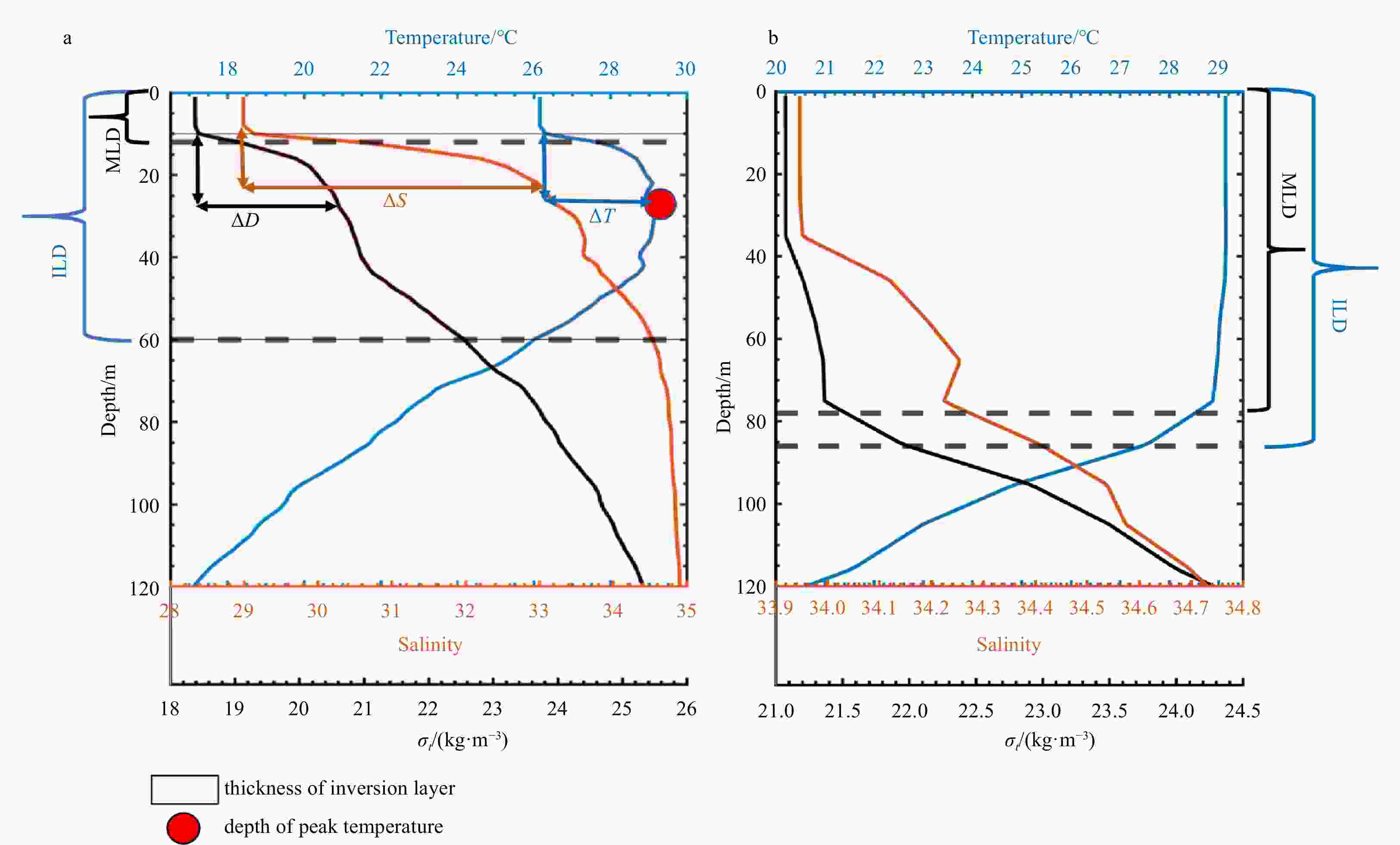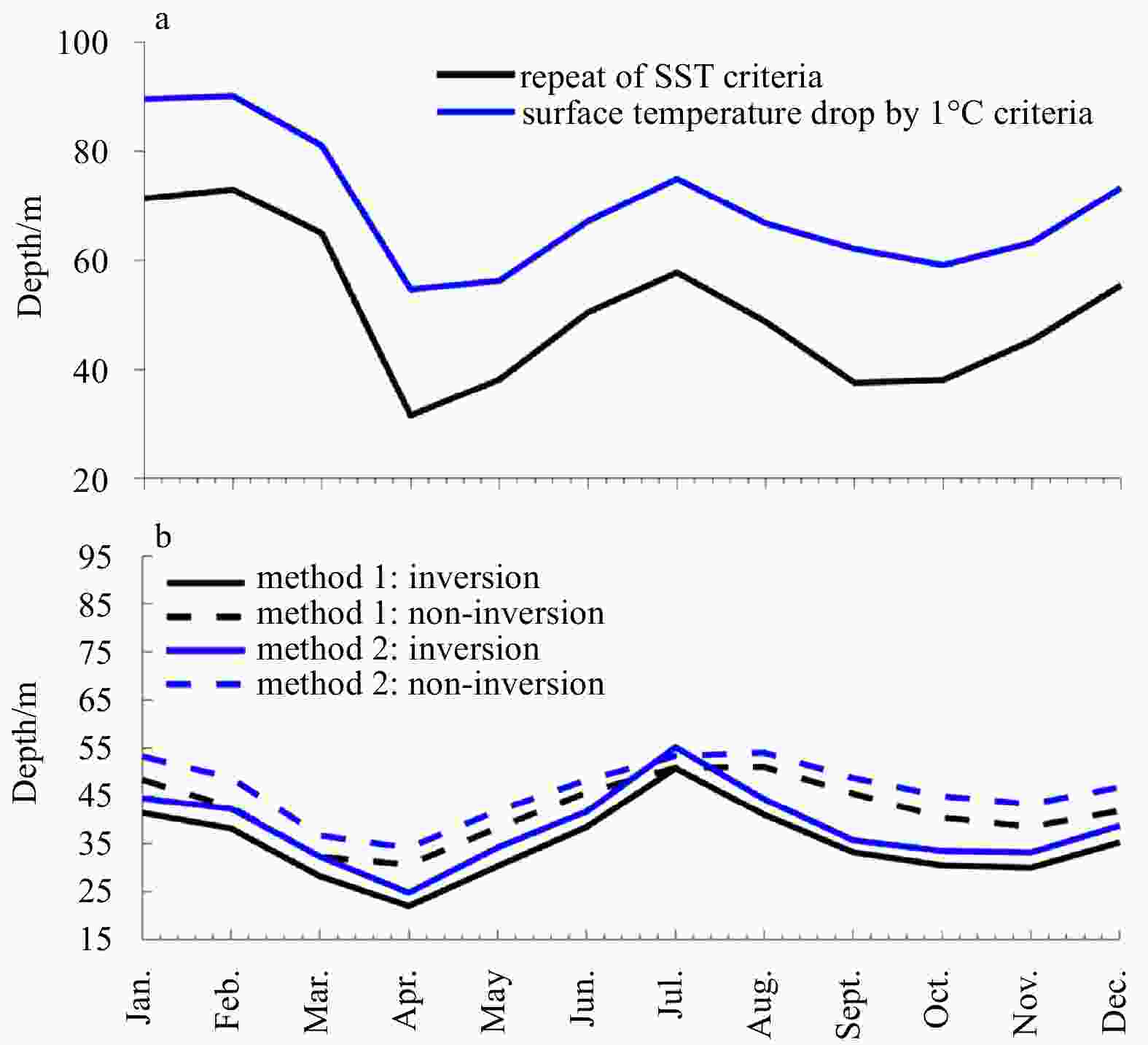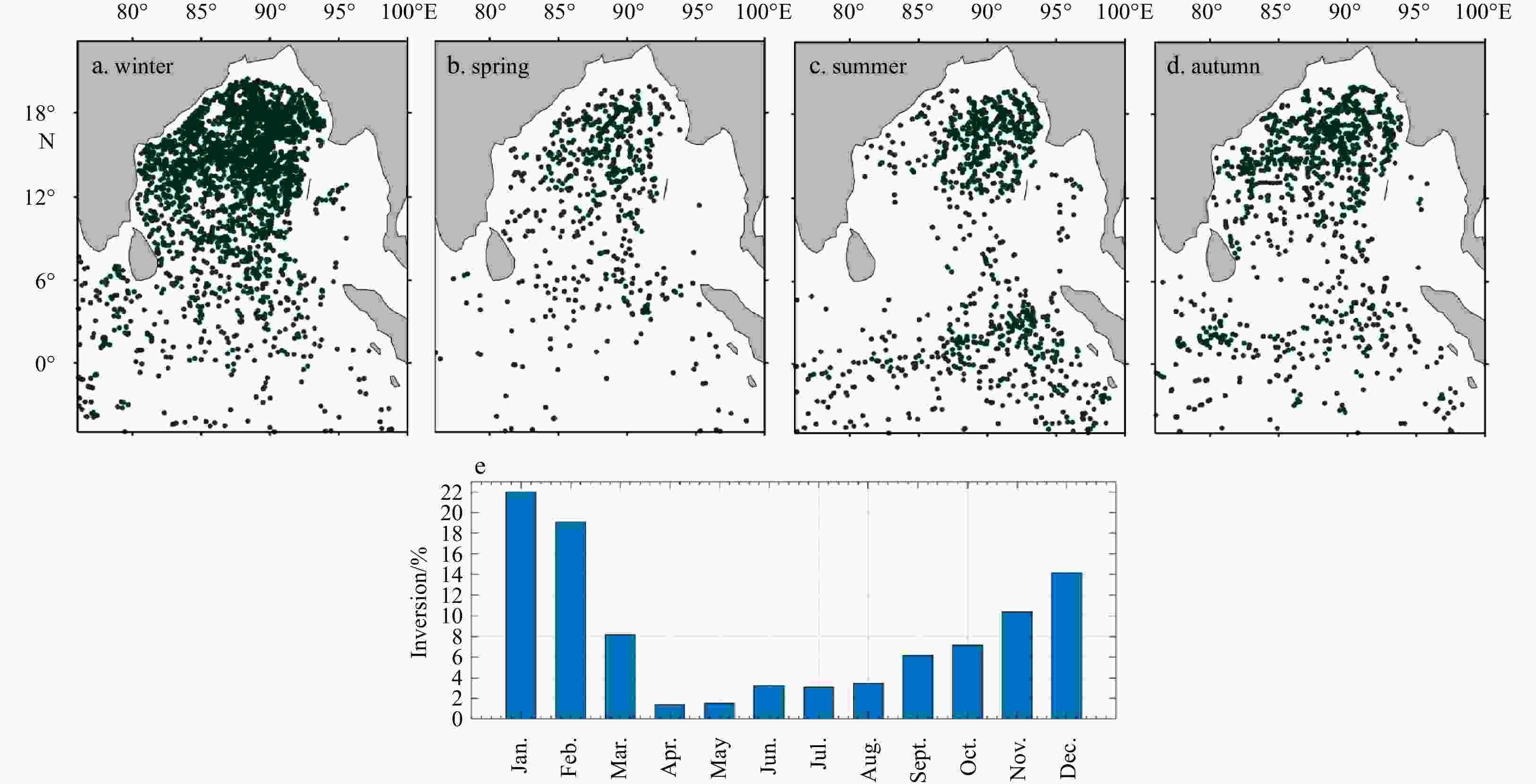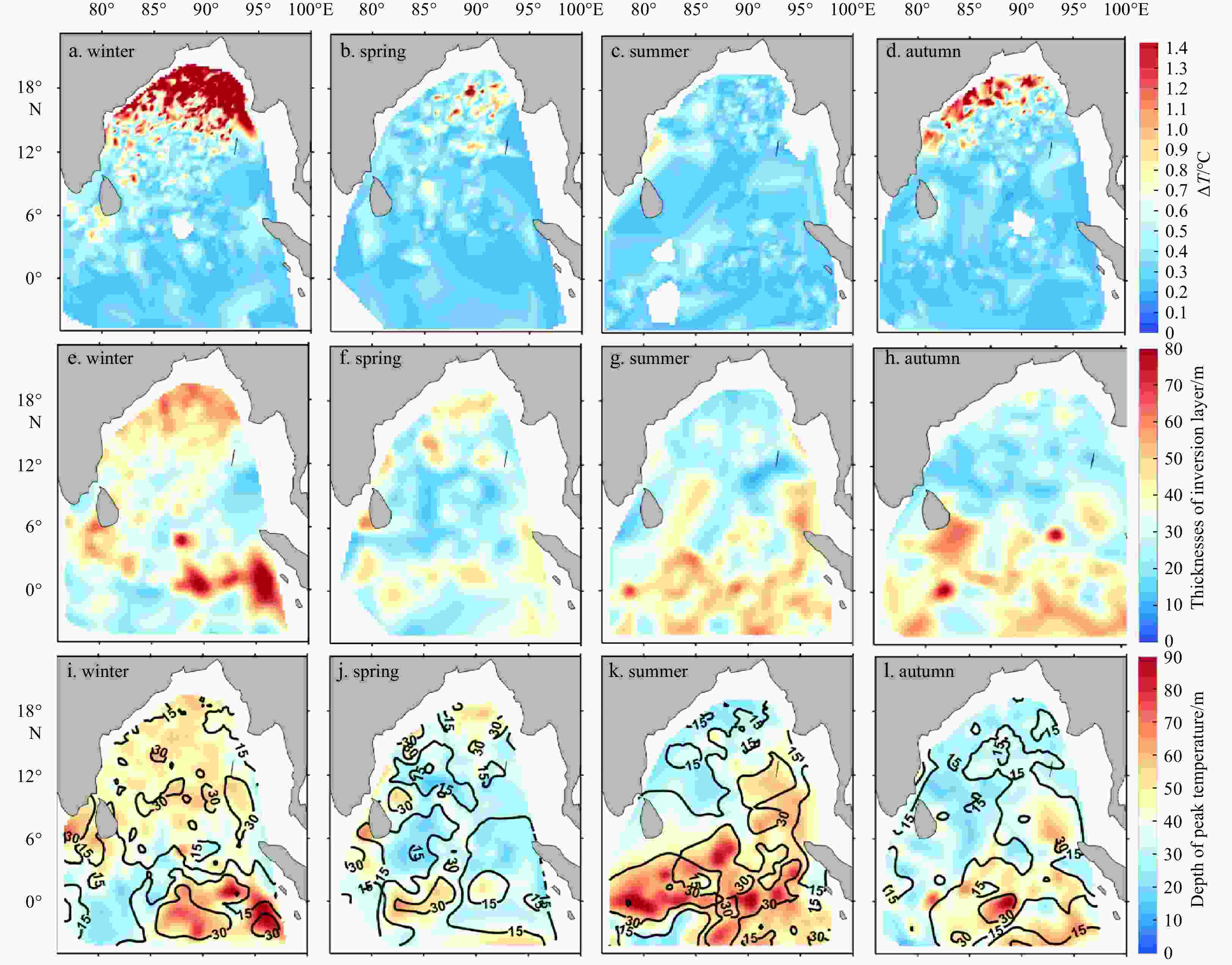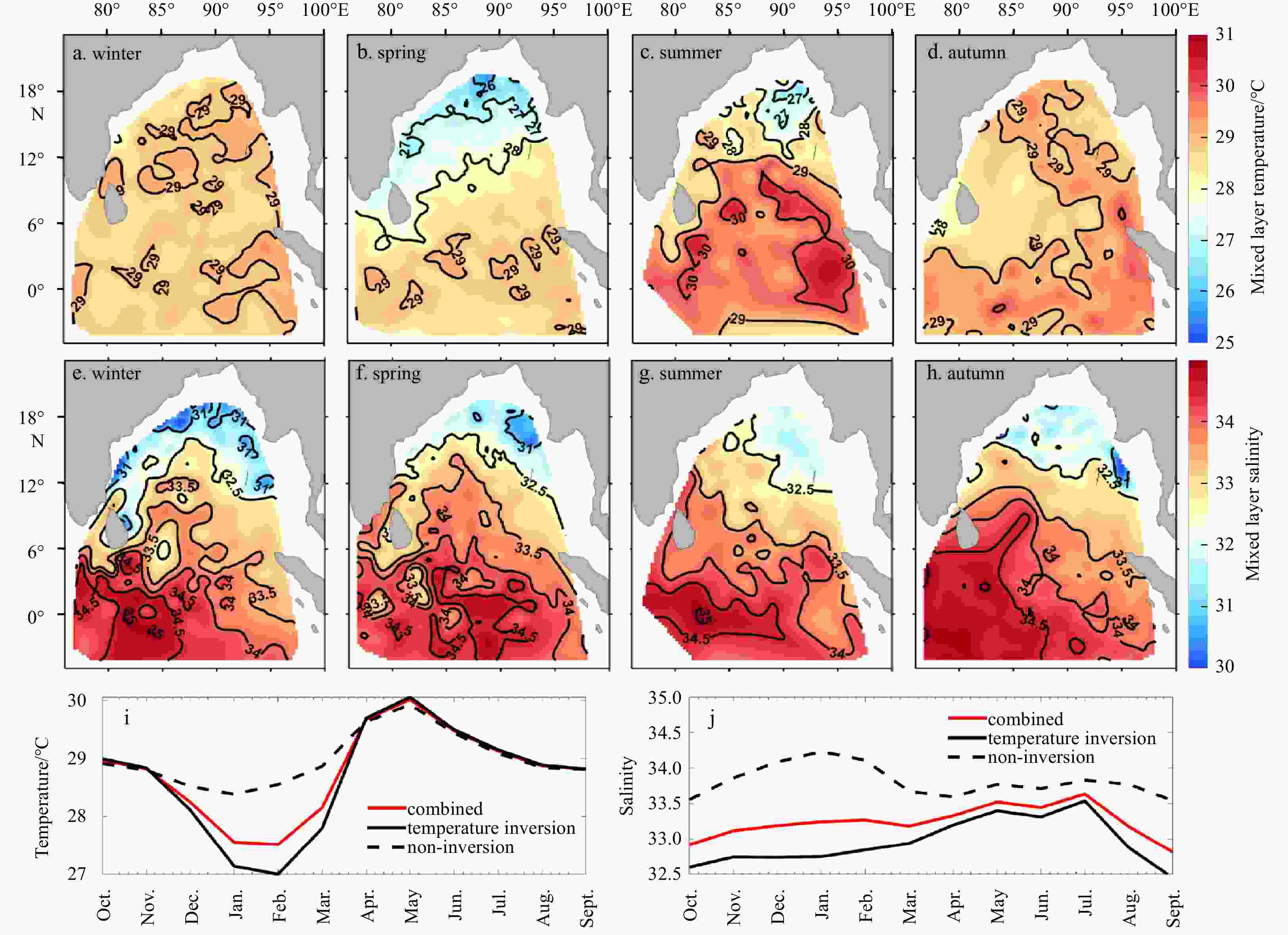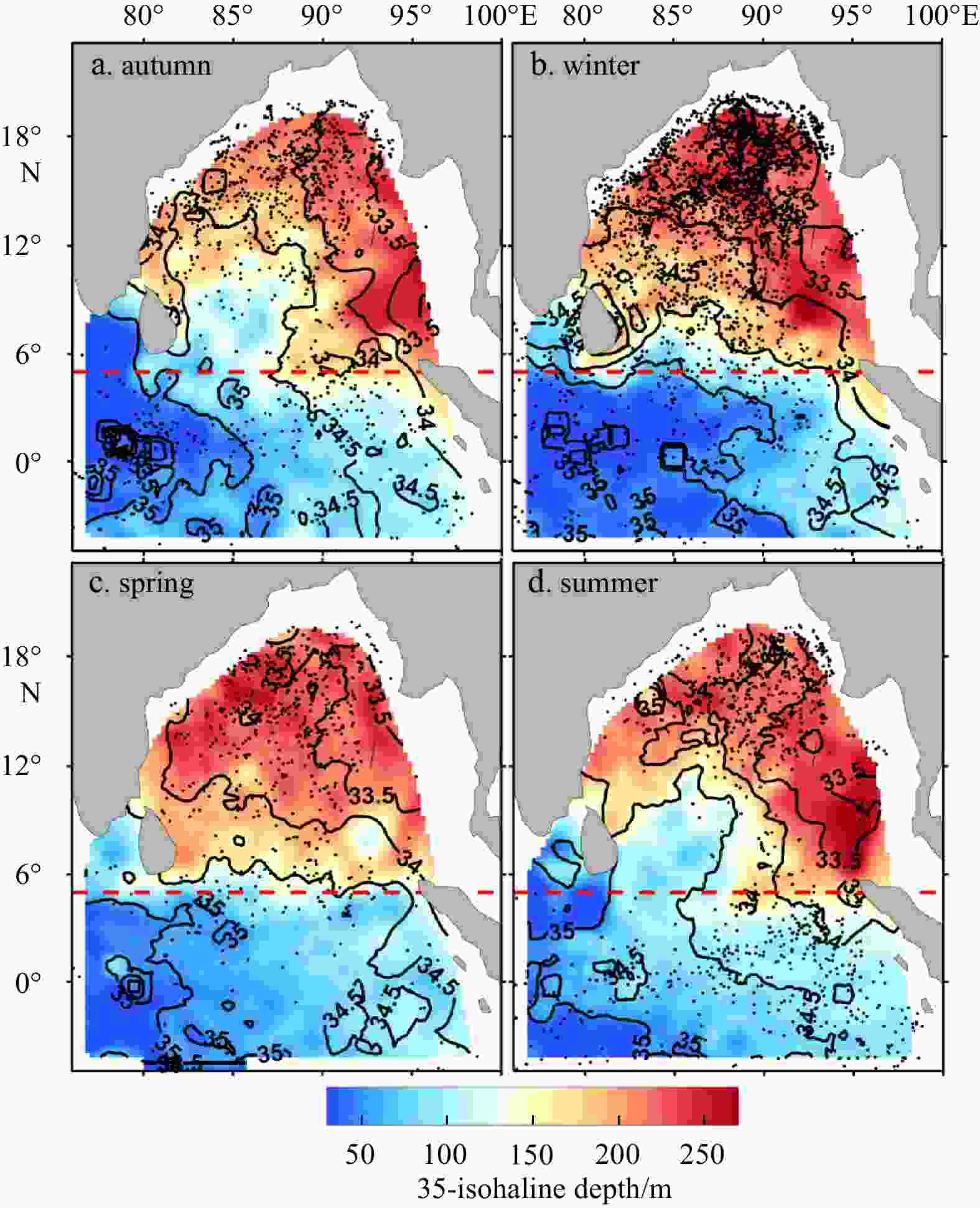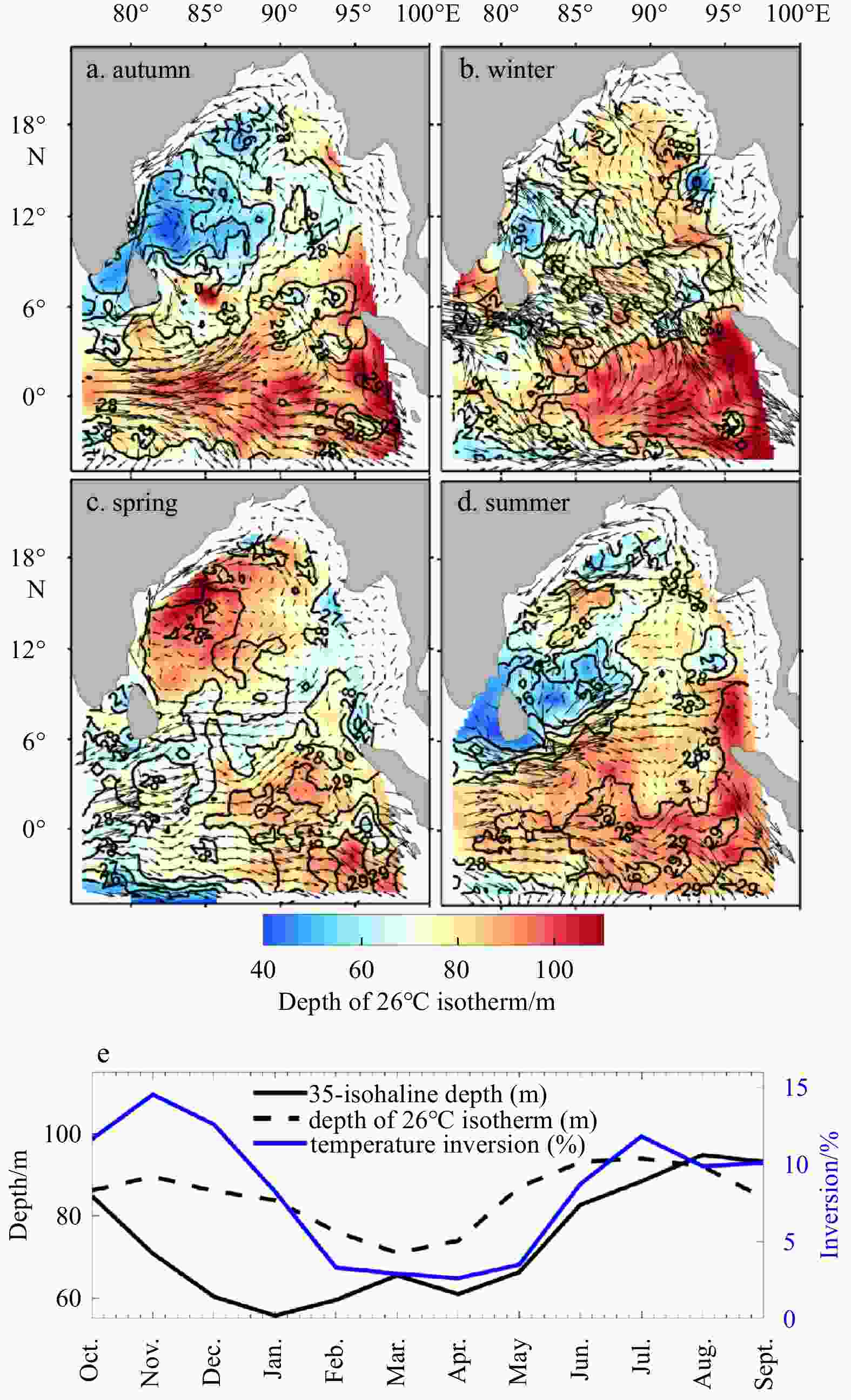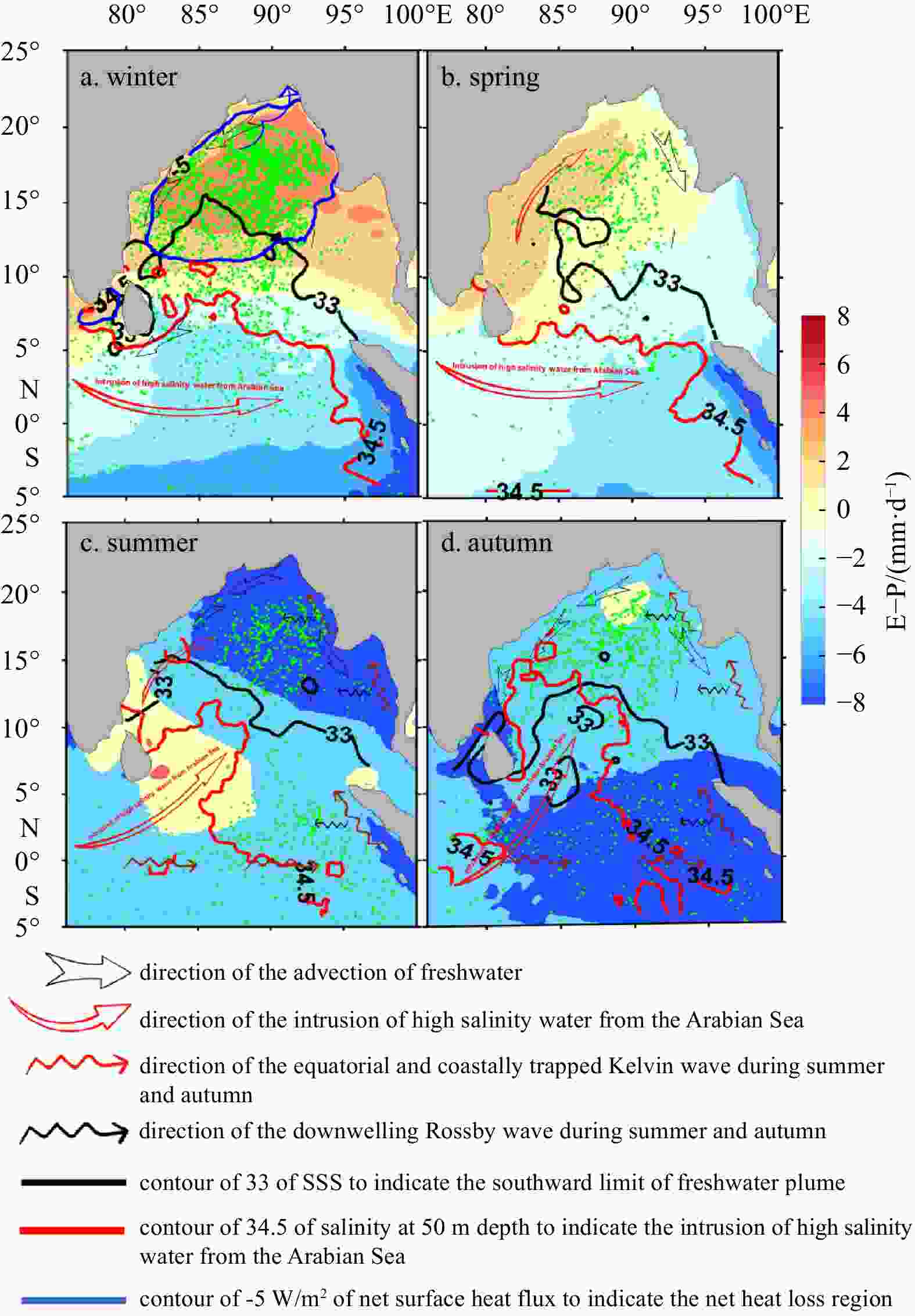Spatiotemporal variation and mechanisms of temperature inversion in the Bay of Bengal and the eastern equatorial Indian Ocean
-
Abstract: In the northern Bay of Bengal, the existence of intense temperature inversion during winter is a widely accepted phenomenon. However, occurrences of temperature inversion during other seasons and the spatial distribution within and adjacent to the Bay of Bengal are not well understood. In this study, a higher resolution spatiotemporal variation of temperature inversion and its mechanisms are examined with mixed layer heat and salt budget analysis utilizing long-term Argo (2004 to 2020) and RAMA (2007 to 2020) profiles data in the Bay of Bengal and eastern equatorial Indian Ocean (EEIO). Temperature inversion exists (17.5% of the total 39 293 Argo and 51.6% of the 28 894 RAMA profiles) throughout the year in the entire study area. It shows strong seasonal variation, with the highest occurrences in winter and the lowest in spring. Besides winter inversion in the northern Bay of Bengal, two other regions with frequent temperature inversion are identified in this study for the first time: the northeastern part of the Bay of Bengal and the eastern part of the EEIO during summer and autumn. Driving processes of temperature inversion for different subregions are revealed in the current study. Penetration of heat (mean ~25 W/m2) below the haline-stratified shallow mixed layer leads to a relatively warmer subsurface layer along with the simultaneous cooling tendency in mixed layer, which controls more occurrence of temperature inversion in the northern Bay of Bengal throughout the year. Comparatively lower cooling tendency due to net surface heat loss and higher mixed layer salinity leaves the southern part of the bay less supportive to the formation of temperature inversion than the northern bay. In the EEIO, slightly cooling tendency in the mixed layer along with the subduction of warm-salty Arabian Sea water beneath the cold-fresher Bay of Bengal water, and downwelling of thermocline creates a favorable environment for forming temperature inversion mainly during summer and autumn. Deeper isothermal layer depth, and thicker barrier layer thickness intensify the temperature inversion both in the Bay of Bengal and EEIO.
-
Figure 1. The number distribution of Argo profiles at 1°×1° grid in the Bay of Bengal and the eastern equatorial Indian Ocean (EEIO). The red dashed line is the boundary between the Bay of Bengal and the EEIO. The eight RAMA mooring buoy are marked by the red diamonds. GBM is short for the Ganges-Brahmaputra-Meghna Rivers; SL is short for the country name Sri Lanka; and IND is for Indonesia.
Figure 8. Basin averaged monthly variation of the 32.5-isohaline depth and the percentages of temperature inversion (a), water column stratification (s−2) in temperature inversion and non-inversion profiles (b), spatiotemporal distribution of ∆S (c–f), monthly variation of ∆T and ∆S (g), and their correlations (h).
Figure 13. Season-wise spatial distribution of mixed layer depth (MLD) (shading) overlaid with contours of initial inversion depth (a–d), isothermal layer depth (ILD) (shading) with contours of depth of peak temperature (e–h), and barrier layer thickness (BLT) (shading) with the contours of thickness of inversion layer (i–l).
Table 1. Basin averaged monthly mean of different characteristic parameters of temperature inversion derived from Argo data
Parameters Jan. Feb. Mar. Apr. May Jun. Jul. Aug. Sept. Oct. Nov. Dec. Inversion profiles 1 518 1 316 567 98 106 226 214 239 427 496 718 978
Inversion/%22.0 19.1 8.2 1.4 1.5 3.3 3.1 3.5 6.2 7.2 10.4 14.2
∆T/°C1.6 1.3 0.7 0.4 0.3 0.4 0.3 0.5 0.3 0.4 0.6 0.9
Initial inversion depth/m19.4 20.9 21.6 11.1 17.3 22.9 29.3 21.5 16.5 14.9 14.8 18.0
Depth of peak temperature/m52.9 54.7 48.8 21.2 31.4 41.5 53.5 43.5 33.1 30.4 34.6 42.6
Thickness of the inversion layer/m52.2 52.6 43.2 19.4 23.2 28.1 34.5 35.1 27.0 26.1 31.1 38.5 Table 2. Temporal mean over 2007 to 2020 of different characteristic parameters of temperature inversion, and seasonal distribution of inversion in different RAMA buoy positions
RAMA position Total profiles Percentage of total TI/% Mean ∆T/°C Mean
DPT/mWinter
/%Spring
/%Summer
/%Autumn
/%0°, 80.5°E 3 511 2.2 0.32 51.7 24.7 7.2 47.4 20.6 0°, 90°E 3 612 2.3 0.28 55.7 23.2 8.5 26.8 41.5 1.5°S, 80.5°E 4 236 3.3 0.42 27.6 25.4 15.6 32.0 27.0 4°S, 80.5°E 3 513 1.5 0.34 29.5 20.8 22.6 28.3 28.3 4°N, 90°E 2 282 3.9 0.36 35.5 48.9 13.3 6.7 31.1 8°N, 90°E 2 910 6.1 0.35 48.4 70.4 10.6 2.8 16.2 12°N. 90°E 4 611 7.8 0.38 47.5 70.7 12.0 8.4 8.9 15°N, 90°E 4 219 24.5 0.73 44.4 70.6 6.2 10.9 12.3 Note: TI stands for temperature inversion and DPT stands for depth of peak temperature. Temperature inversion along EEIO during summer and autumn, and along the Bay of Bengal during winter are remarkable, and thus, shown to be “bold italic” faces. Table 3. Correlation between the number of temperature inversion with associated parameters in the study domain
MHF NHF MLT MFWF E–P MLS ∆S ∆D 32.5 isohaline W.TKE Number of temperature inversion −0.76 −0.79 −0.91 0.41 0.46 −0.54 0.94 0.70 0.44 −0.42 Note: MHF, NHF, MLT, MFWF, MLS, and W.TKE represent mixed layer heat flux, net surface heat flux, mixed layer temperature, mixed layer fresh-water flux, mixed layer salinity, and wind turbulent kinetic energy, respectively. More than 95% significant correlations are shown to be “bold italic” faces. -
[1] Akhil V P, Durand F, Lengaigne M, et al. 2014. A modeling study of the processes of surface salinity seasonal cycle in the Bay of Bengal. Journal of Geophysical Research: Oceans, 119(6): 3926–3947. doi: 10.1002/2013JC009632 [2] Argo. 2021. Argo float data and metadata from Global Data Assembly Centre (Argo GDAC). Plouzané: SEANOE, [3] Balaguru K, Chang Ping, Saravanan R, et al. 2012. Ocean barrier layers’ effect on tropical cyclone intensification. Proceedings of the National Academy of Sciences of the United States of America, 109(36): 14343–14347. doi: 10.1073/pnas.1201364109 [4] Chaitanya A V S, Lengaigne M, Vialard J, et al. 2014. Salinity measurements collected by fishermen reveal a “River in the Sea” flowing along the eastern coast of India. Bulletin of the American Meteorological Society, 95(12): 1897–1908. doi: 10.1175/BAMS-D-12-00243.1 [5] Chowdhury K M A, Jiang Wensheng, Liu Guimei, et al. 2019. Formation and types of thermal inversion in the Bay of Bengal. CLIVAR Exchanges, 76: 20–23 [6] Chowdhury K M A, Mahbub-E-Kibria A S M, Akhter S, et al. 2017. Variation of water column density in the Bay of Bengal aquatic ecosystem. International Journal of Fisheries and Aquatic Studies, 5(6): 34–40 [7] De Boyer Montégut C, Madec G, Fischer A S, et al. 2004. Mixed layer depth over the global ocean: An examination of profile data and a profile-based climatology. Journal of Geophysical Research: Oceans, 109(C12): C12003. doi: 10.1029/2004jc002378 [8] De Boyer Montégut C, Mignot J, Lazar A, et al. 2007. Control of salinity on the mixed layer depth in the world ocean: 1. general description. Journal of Geophysical Research: Oceans, 112(C6): C06011. doi: 10.1029/2006JC003953 [9] Durand F, Shetye S R, Vialard J, et al. 2004. Impact of temperature inversions on SST evolution in the South-Eastern Arabian Sea during the pre-summer monsoon season. Geophysical Research Letters, 31(1): L01305. doi: 10.1029/2003GL018906 [10] Foltz G R, McPhaden M J. 2009. Impact of barrier layer thickness on SST in the central tropical North Atlantic. Journal of Climate, 22(2): 285–299. doi: 10.1175/2008JCLI2308.1 [11] Girishkumar M S, Ravichandran M, McPhaden M J. 2013. Temperature inversions and their influence on the mixed layer heat budget during the winters of 2006–2007 and 2007–2008 in the Bay of Bengal. Journal of Geophysical Research: Oceans, 118(5): 2426–2437. doi: 10.1002/jgrc.20192 [12] Girishkumar M S, Ravichandran M, McPhaden M J, et al. 2011. Intraseasonal variability in barrier layer thickness in the south central Bay of Bengal. Journal of Geophysical Research: Oceans, 116(C3): C03009. doi: 10.1029/2010JC006657 [13] Godfrey J S, Lindstrom E J. 1989. The heat budget of the equatorial western Pacific surface mixed layer. Journal of Geophysical Research: Oceans, 94(C6): 8007–8017. doi: 10.1029/JC094iC06p08007 [14] Halkides D, Lee T. 2011. Mechanisms controlling seasonal mixed layer temperature and salinity in the southwestern tropical Indian Ocean. Dynamics of Atmospheres and Oceans, 51(3): 77–93. doi: 10.1016/j.dynatmoce.2011.03.002 [15] He Qingyou, Zhan Haigang, Cai Shuqun. 2020. Anticyclonic eddies enhance the winter barrier layer and surface cooling in the Bay of Bengal. Journal of Geophysical Research: Oceans, 125(10): e2020JC016524. doi: 10.1029/2020JC016524 [16] Kara A B, Rochford P A, Hurlburt H E. 2000. Mixed layer depth variability and barrier layer formation over the North Pacific Ocean. Journal of Geophysical Research: Oceans, 105(C7): 16783–16801. doi: 10.1029/2000JC900071 [17] Kashem M, Ahmed M K, Qiao Fangli, et al. 2019. The response of the upper ocean to tropical cyclone Viyaru over the Bay of Bengal. Acta Oceanologica Sinica, 38(1): 61–70. doi: 10.1007/s13131-019-1370-1 [18] Kumari A, Kumar S P, Chakraborty A. 2018. Seasonal and interannual variability in the barrier layer of the Bay of Bengal. Journal of Geophysical Research: Oceans, 123(2): 1001–1015. doi: 10.1002/2017JC013213 [19] Kurian J, Vinayachandran P N. 2006. Formation mechanisms of temperature inversions in the southeastern Arabian Sea. Geophysical Research Letters, 33(17): L17611. doi: 10.1029/2006GL027280 [20] Li Kuiping, Wang Haiyuan, Yang Yang, et al. 2016. Observed characteristics and mechanisms of temperature inversion in the northern Bay of Bengal. Haiyang Xuebao, 38(7): 22–31 [21] Li Jian, Yang Lei, Shu Yeqiang, et al. 2012. Temperature inversion in the Bay of Bengal prior to the summer monsoon onsets in 2010 and 2011. Atmospheric and Oceanic Science Letters, 5(4): 290–294. doi: 10.1080/16742834.2012.11447004 [22] Luis A J, Kawamura H. 2000. Wintertime wind forcing and sea surface cooling near the south India tip observed using NSCAT and AVHRR. Remote Sensing of Environment, 73(1): 55–64. doi: 10.1016/S0034-4257(00)00081-X [23] Ma Tian, Qi Yiquan, Cheng Xuhua. 2019. Intraseasonal-to-semiannual variability of barrier layer thickness in the eastern equatorial Indian Ocean and Bay of Bengal. Journal of Tropical Oceanography, 38(5): 18–31 [24] Masson S, Delecluse P, Boulanger J P, et al. 2002. A model study of the seasonal variability and formation mechanisms of the barrier layer in the eastern equatorial Indian Ocean. Journal of Geophysical Research: Oceans, 107(C12): 8017. doi: 10.1029/2001JC000832 [25] Mignot J, Lazar A, Lacarra M. 2012. On the formation of barrier layers and associated vertical temperature inversions: a focus on the northwestern tropical Atlantic. Journal of Geophysical Research: Oceans, 117(C2): C02010. doi: 10.1029/2011JC007435 [26] Monterey G I, Levitus S. 1997. Seasonal Variability of Mixed Layer Depth for the World Ocean. Silver Spring: NOAA [27] Morel A, Antoine D. 1994. Heating rate within the upper ocean in relation to its bio-optical state. Journal of Physical Oceanography, 24(7): 1652–1665. doi: 10.1175/1520-0485(1994)024<1652:HRWTUO>2.0.CO;2 [28] Nagata Y. 1970. Detailed temperature cross section of the cold-water belt along the northern edge of the Kuroshio. Journal of Marine Research, 28(1): 1–14 [29] Pant V, Girishkumar M S, Bhaskar T V S U, et al. 2015. Observed interannual variability of near-surface salinity in the Bay of Bengal. Journal of Geophysical Research: Oceans, 120(5): 3315–3329. doi: 10.1002/2014JC010340 [30] Qu Tangdong, Meyers G. 2005. Seasonal variation of barrier layer in the southeastern tropical Indian Ocean. Journal of Geophysical Research: Oceans, 110(C11): C11003. doi: 10.1029/2004JC002816 [31] Rao B P, Babu V R, Chandramohan P. 1987. Seasonal and diurnal variability of thermal structure in the coastal waters off Visakhapatnam. Proceedings of the Indian Academy of Sciences-Earth and Planetary Sciences, 96(1): 69–79. doi: 10.1007/BF02842639 [32] Rao R R, Kumar M S G, Ravichandran M, et al. 2010. Interannual variability of Kelvin wave propagation in the wave guides of the equatorial Indian Ocean, the coastal Bay of Bengal and the southeastern Arabian Sea during 1993–2006. Deep-Sea Research Part I: Oceanographic Research Papers, 57(1): 1–13. doi: 10.1016/j.dsr.2009.10.008 [33] Rao R R, Rao D S, Murthy P G K, et al. 1983. A preliminary investigation of the summer monsoonal forcing on the thermal structure of upper Bay of Bengal during Monex-79. Mausum, 32: 85–92 [34] Rao R R, Sivakumar R. 2003. Seasonal variability of sea surface salinity and salt budget of the mixed layer of the north Indian Ocean. Journal of Geophysical Research: Oceans, 108(C1): 3009. doi: 10.1029/2001JC000907 [35] Roseli N H, Akhir M F, Husain M L, et al. 2015. Water mass characteristics and stratification at the shallow Sunda Shelf of southern South China Sea. Open Journal of Marine Science, 5(4): 455–467. doi: 10.4236/ojms.2015.54036 [36] Schiller A, Godfrey J S. 2003. Indian Ocean intraseasonal variability in an ocean general circulation model. Journal of Climate, 16(1): 21–39. doi: 10.1175/1520-0442(2003)016<0021:IOIVIA>2.0.CO;2 [37] Shankar D, Gopalakrishna V V, Shenoi S S C, et al. 2004. Observational evidence for westward propagation of temperature inversions in the southeastern Arabian Sea. Geophysical Research Letters, 31(8): L08305. doi: 10.1029/2004GL019652 [38] Shankar D, Remya R, Vinayachandran P N, et al. 2016. Inhibition of mixed-layer deepening during winter in the northeastern Arabian Sea by the West India Coastal Current. Climate Dynamics, 47(3-4): 1049–1072. doi: 10.1007/s00382-015-2888-3 [39] Shee A, Sil S, Gangopadhyay A, et al. 2019. Seasonal evolution of oceanic upper layer processes in the northern Bay of Bengal following a single Argo float. Geophysical Research Letters, 46(10): 5369–5377. doi: 10.1029/2019GL082078 [40] Shetye S R, Gouveia A D, Shankar D, et al. 1996. Hydrography and circulation in the western Bay of Bengal during the northeast monsoon. Journal of Geophysical Research: Oceans, 101(C6): 14011–14025. doi: 10.1029/95JC03307 [41] Shetye S R, Gouveia A D, Shenoi S S C, et al. 1993. The western boundary current of the seasonal subtropical gyre in the Bay of Bengal. Journal of Geophysical Research: Oceans, 98(C1): 945–954. doi: 10.1029/92JC02070 [42] Sprintall J, Tomczak M. 1992. Evidence of the barrier layer in the surface layer of the tropics. Journal of Geophysical Research: Oceans, 97(C5): 7305–7316. doi: 10.1029/92JC00407 [43] Srivastava A, Dwivedi S, Mishra A K. 2018. Investigating the role of air-sea forcing on the variability of hydrography, circulation, and mixed layer depth in the Arabian Sea and Bay of Bengal. Oceanologia, 60(2): 169–186. doi: 10.1016/j.oceano.2017.10.001 [44] Suryanarayana A, Murty V S N, Rao D P. 1993. Hydrography and circulation of the Bay of Bengal during early winter, 1983. Deep-Sea Research Part I: Oceanographic Research Papers, 40(1): 205–217. doi: 10.1016/0967-0637(93)90061-7 [45] Sweeney C, Gnanadesikan A, Griffies S M, et al. 2005. Impacts of shortwave penetration depth on large-scale ocean circulation and heat transport. Journal of Physical Oceanography, 35(6): 1103–1119. doi: 10.1175/JPO2740.1 [46] Thadathil P, Gopalakrishna V V, Muraleedharan P M, et al. 2002. Surface layer temperature inversion in the Bay of Bengal. Deep-Sea Research Part I: Oceanographic Research Papers, 49(10): 1801–1818. doi: 10.1016/S0967-0637(02)00044-4 [47] Thadathil P, Gosh A K. 1992. Surface layer temperature inversion in the Arabian Sea during winter. Journal of Oceanography, 48(3): 293–304. doi: 10.1007/BF02233989 [48] Thadathil P, Muraleedharan P M, Rao R R, et al. 2007. Observed seasonal variability of barrier layer in the Bay of Bengal. Journal of Geophysical Research: Oceans, 112(C2): C02009. doi: 10.1029/2006JC003651 [49] Thadathil P, Suresh I, Gautham S, et al. 2016. Surface layer temperature inversion in the Bay of Bengal: main characteristics and related mechanisms. Journal of Geophysical Research: Oceans, 121(8): 5682–5696. doi: 10.1002/2016JC011674 [50] Thompson B, Gnanaseelan C, Salvekar P S. 2006. Seasonal evolution of temperature inversions in the north Indian Ocean. Current Science, 90(5): 697–704 [51] Ueno H, Oka E, Suga T, et al. 2005. Seasonal and interannual variability of temperature inversions in the subarctic North Pacific. Geophysical Research Letters, 32(20): L20603. doi: 10.1029/2005GL023948 [52] Vialard J, Delecluse P. 1998. An OGCM study for the TOGA decade. Part II: barrier-Layer formation and variability. Journal of Physical Oceanography, 28(6): 1089–1106. doi: 10.1175/1520-0485(1998)028<1089:AOSFTT>2.0.CO;2 [53] Vialard J, Foltz G R, McPhaden M J, et al. 2008. Strong Indian Ocean sea surface temperature signals associated with the Madden-Julian Oscillation in late 2007 and early 2008. Geophysical Research Letters, 35(19): L19608. doi: 10.1029/2008GL035238 [54] Vinayachandran P N, Murty V S N, Babu V R. 2002. Observations of barrier layer formation in the Bay of Bengal during summer monsoon. Journal of Geophysical Research: Oceans, 107(C12): 8018. doi: 10.1029/2001JC000831 [55] Vinayachandran P N, Shankar D, Vernekar S, et al. 2013. A summer monsoon pump to keep the Bay of Bengal salty. Geophysical Research Letters, 40(9): 1777–1782. doi: 10.1002/grl.50274 [56] Wong A, Keeley R, Carval T, et al. 2021. Argo quality control manual for CTD and trajectory data.https://archimer.ifremer.fr/doc/00228/33951/32470.pdf [2021-05-11/2021-06-20] [57] Wyrtki K, Bennett E B, Rochford D J. 1971. Oceanographic Atlas of the International Indian Ocean Expedition. Washington: National Science Foundation, 531 [58] Yu Lisan. 2003. Variability of the depth of the 20°C isotherm along 6°N in the Bay of Bengal: its response to remote and local forcing and its relation to satellite SSH variability. Deep-Sea Research Part II: Topical Studies in Oceanography, 50(12–13): 2285–2304. doi: 10.1016/S0967-0645(03)00057-2 -




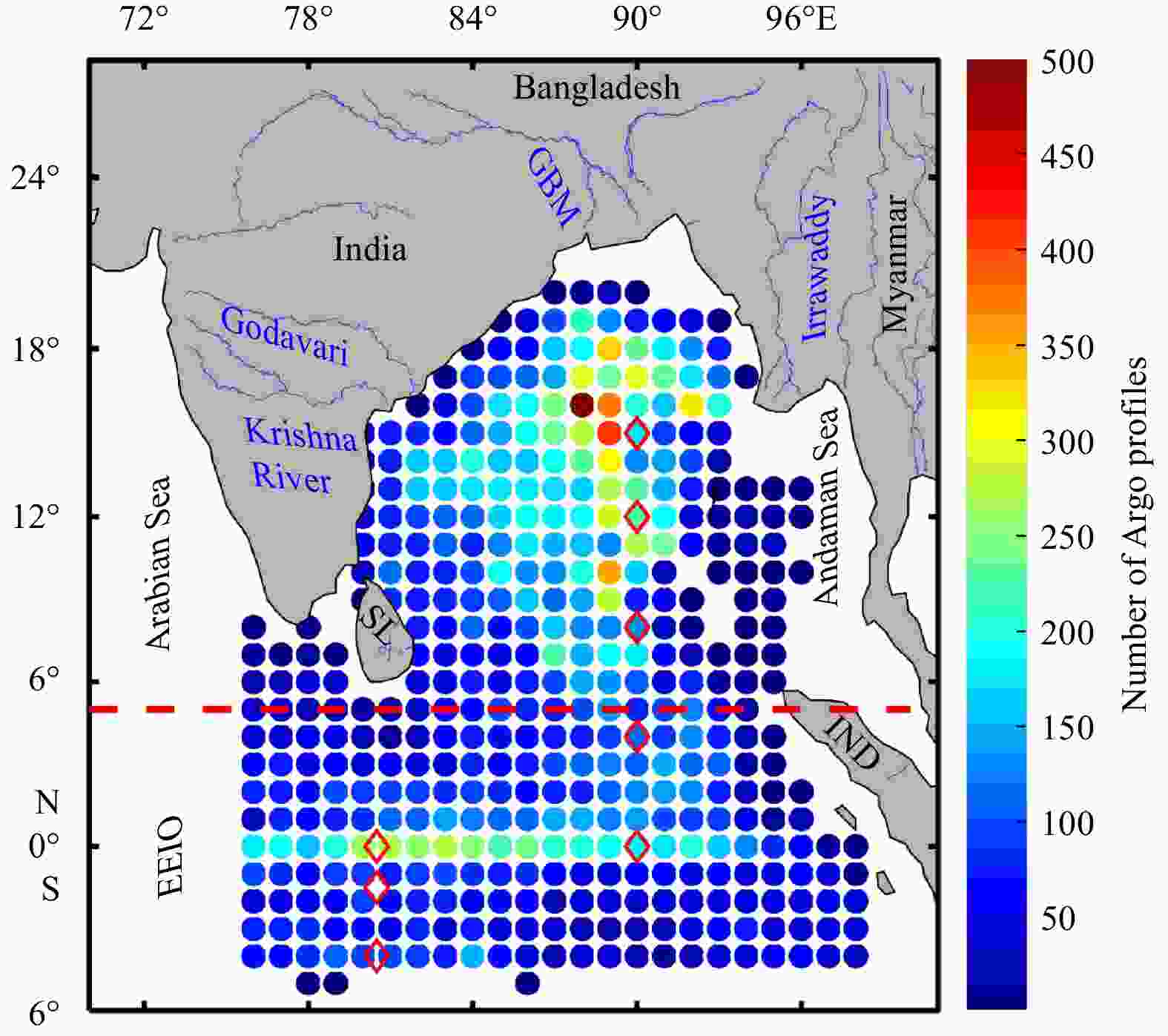
 下载:
下载:
